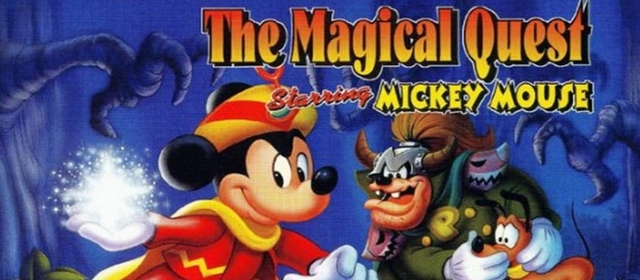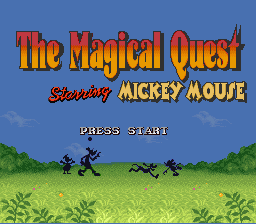
When you look at Disney games today, you can easily expect to find the exact same title on any platform of your choosing. That wasn’t always the case, however, and in the early nineties rights to produce Disney titles were split in a genre-specific manner. SEGA produced their own Disney titles for their Mega Drive, Master System and Game Gear consoles – which lead to the very popular Castle of Illusion, just to name one (which of course has received an HD remake just this month). At the same time, Capcom were producing titles featuring Mickey and Co. on Nintendo systems.
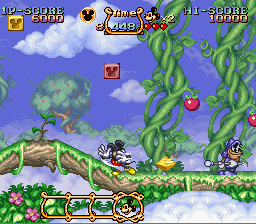 This was great for gamers in terms of variety – so you had a real choice of different titles to play – but also a shame because those gamers who didn’t have access to multiple console formats would undoubtedly miss out on fifty percent of the titles, whether they were good or bad. One of these games that saw a Super Nintendo release, but never went multi-platform, was The Magical Quest Starring Mickey Mouse. And whilst the game may not have been as challenging as its Mega Drive counterpart Castle of Illusion, it was certainly a lot more inventive.
This was great for gamers in terms of variety – so you had a real choice of different titles to play – but also a shame because those gamers who didn’t have access to multiple console formats would undoubtedly miss out on fifty percent of the titles, whether they were good or bad. One of these games that saw a Super Nintendo release, but never went multi-platform, was The Magical Quest Starring Mickey Mouse. And whilst the game may not have been as challenging as its Mega Drive counterpart Castle of Illusion, it was certainly a lot more inventive.
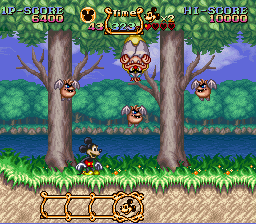 The title begins as Mickey Mouse, Pluto, Goofy and Donald Duck are in the park, innocently playing a game of catch. Leave it to Goofy though, to throw it too far – leading to him and Pluto chasing the ball off into the distance. Mickey soon becomes worried about where his friends have got to, but as he searches for them he suddenly falls down a magically-appearing cliff and into a new and strange land. Here Mickey finds himself above the clouds, with Beanstalks all around – perhaps a flashback to one of his very early cartoons – and here a magician tells him that the evil Emperor Peter has taken Pluto, so Mickey must set out to free the land of his tyranny.
The title begins as Mickey Mouse, Pluto, Goofy and Donald Duck are in the park, innocently playing a game of catch. Leave it to Goofy though, to throw it too far – leading to him and Pluto chasing the ball off into the distance. Mickey soon becomes worried about where his friends have got to, but as he searches for them he suddenly falls down a magically-appearing cliff and into a new and strange land. Here Mickey finds himself above the clouds, with Beanstalks all around – perhaps a flashback to one of his very early cartoons – and here a magician tells him that the evil Emperor Peter has taken Pluto, so Mickey must set out to free the land of his tyranny.
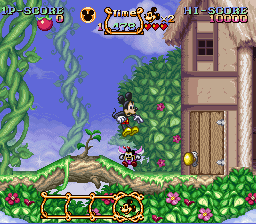 The game begins as a somewhat simple platform title – the usual conventions apply whereby bouncing on the noggin of an enemy will stun them, but you can also grab them once stunned and spin to hurl them at further enemies – a’la Koopa shells in a Mario game. All very standard so far, but from the very first screen Mickey can make use of an interesting technique to ascend to new heights. He can grab fruit, and with a quick spin of its leaves, send it flying into the air like a helicopter. Simply grab hold of this before it floats away and you can use it like an elevator, quickly helping you reach far-away platforms.
The game begins as a somewhat simple platform title – the usual conventions apply whereby bouncing on the noggin of an enemy will stun them, but you can also grab them once stunned and spin to hurl them at further enemies – a’la Koopa shells in a Mario game. All very standard so far, but from the very first screen Mickey can make use of an interesting technique to ascend to new heights. He can grab fruit, and with a quick spin of its leaves, send it flying into the air like a helicopter. Simply grab hold of this before it floats away and you can use it like an elevator, quickly helping you reach far-away platforms.
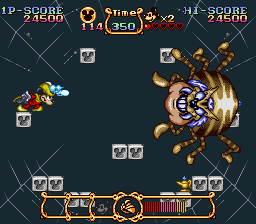 As players move from level to level, they will experience many platform game stereotypes, such as the ice level, a forest level and a fire level – but it is the variety of boss battles and power-ups that makes the game more fascinating. Firstly, the bosses in-game are all different versions of classic Mickey Mouse antagonist Pete – such as a huge Spider with the head of Pete, or a Snake with an uncanny resemblance to the Emperor. They all have set patterns, but working out how you need to defeat them, what skills to make use of and timing your attacks is actually a lot of fun, not just repetitive and boring.
As players move from level to level, they will experience many platform game stereotypes, such as the ice level, a forest level and a fire level – but it is the variety of boss battles and power-ups that makes the game more fascinating. Firstly, the bosses in-game are all different versions of classic Mickey Mouse antagonist Pete – such as a huge Spider with the head of Pete, or a Snake with an uncanny resemblance to the Emperor. They all have set patterns, but working out how you need to defeat them, what skills to make use of and timing your attacks is actually a lot of fun, not just repetitive and boring.
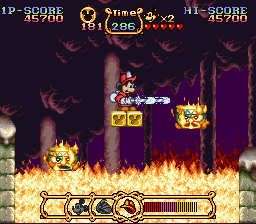 However, what really sets the title apart are the outfit power-ups that Mickey can take advantage of. Aside from his regular outfit that allows you to perform the hurling and spinning attacks, there are three more costumes that grant him a whole range of different abilities. As the second stage begins, Goofy appears and hands you the Magician outfit – which makes Mickey look more like a Genie. With this costume equipped our intrepid mouse can command magic carpets and shoot magical attacks at his enemies. You can charge up your shots by holding the action button, but be careful as your usage is limited by your magic meter, that can only be re-filled through locating a Magic Lamp. His magic can even help you breathe underwater for extended periods.
However, what really sets the title apart are the outfit power-ups that Mickey can take advantage of. Aside from his regular outfit that allows you to perform the hurling and spinning attacks, there are three more costumes that grant him a whole range of different abilities. As the second stage begins, Goofy appears and hands you the Magician outfit – which makes Mickey look more like a Genie. With this costume equipped our intrepid mouse can command magic carpets and shoot magical attacks at his enemies. You can charge up your shots by holding the action button, but be careful as your usage is limited by your magic meter, that can only be re-filled through locating a Magic Lamp. His magic can even help you breathe underwater for extended periods.
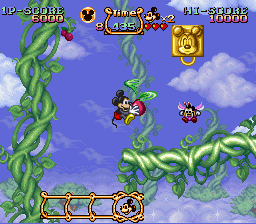 The third level brings with it your third costume change – and now Mickey turns all Backdraft on us as he dons a Firefighter uniform – complete with a hose for dousing bad guys. You can, of course, also use the hose to extinguish fire in your path, but you can also use jets of water to fire heavy objects out of your way or fire it in cool places to make icicles. Again, usage is metered and this time you top it back up by finding a fire hydrant power-up.
The third level brings with it your third costume change – and now Mickey turns all Backdraft on us as he dons a Firefighter uniform – complete with a hose for dousing bad guys. You can, of course, also use the hose to extinguish fire in your path, but you can also use jets of water to fire heavy objects out of your way or fire it in cool places to make icicles. Again, usage is metered and this time you top it back up by finding a fire hydrant power-up.
The fourth and final costume at Mickey’s disposal is his mountain-climbing Matterhorn outfit – which makes him look just like Peter Pan. This decks our hero out with a handy grappling-hook, allowing the player to pull themselves up to higher platforms, grab faraway items or swing from certain objects. If you find yourself in a bind you can also fire it at an enemy to stun them too – a very versatile grappling hook. These different costumes and the abilities that come with them really add a lot of variety to the gameplay. Each level plays quite differently because of this fact and it means that there is little repetition in the gameplay. There is always something new to try out and experiment with.
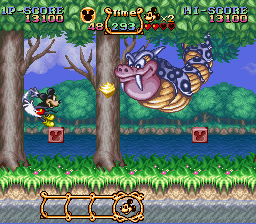 Graphically the game was very good for the time – bright and bold sprites filled the screen and the animation throughout the title was smooth and had lots of nice little touches that brought the characters to life. The visuals during the Peter boss battles were particularly impressive, with the huge monsters inhabiting the screen. Musically the game wasn’t going to win any awards and whilst they certainly conveyed a sense of being in a Disney cartoon, the tracks were all a little derivative and forgettable.
Graphically the game was very good for the time – bright and bold sprites filled the screen and the animation throughout the title was smooth and had lots of nice little touches that brought the characters to life. The visuals during the Peter boss battles were particularly impressive, with the huge monsters inhabiting the screen. Musically the game wasn’t going to win any awards and whilst they certainly conveyed a sense of being in a Disney cartoon, the tracks were all a little derivative and forgettable.
Having only a handful of levels in the game, you would expect The Magical Quest to be tough as nails, right? Wrong – the game allowed for unlimited continues and rather than suffering one-hit kills, the player had a life bar that they could re-fill quite easily by finding the plentiful hearts scattered around the stages. You can alter the difficulty setting, but the fact unfortunately remains that the game is very short and doesn’t pose too great a challenge. A tacked-on multiplayer mode doesn’t really add to the longevity of the game, as rather than a co-operative mode, which could have been great, all we get is a mode where two players take turns to play the same levels.
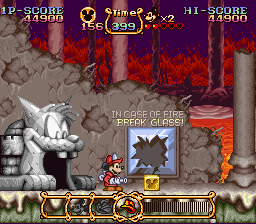 The Magical Quest may not have been perfect in every way, but the game certainly tried out some new ideas and tried to keep the gameplay fresh and exciting. This was in the days back before almost every Disney game had to be a film or TV license and Capcom managed to produce a clever original title. The game was so well-loved that it received two more sequels (one exclusively in Japan) and was after ported onto the Gameboy Advance. But it was the original game that started it all and introduced the great costume system – perhaps we should also be seeing an HD remake of The Magical Quest sometime in the future if Castle of Illusion is a success?
The Magical Quest may not have been perfect in every way, but the game certainly tried out some new ideas and tried to keep the gameplay fresh and exciting. This was in the days back before almost every Disney game had to be a film or TV license and Capcom managed to produce a clever original title. The game was so well-loved that it received two more sequels (one exclusively in Japan) and was after ported onto the Gameboy Advance. But it was the original game that started it all and introduced the great costume system – perhaps we should also be seeing an HD remake of The Magical Quest sometime in the future if Castle of Illusion is a success?
This will be the final entry of the GodisaGeek Retro Corner. I would like to thank all of my readers for your support over the last three years of uninterrupted monthly articles – where we have looked at some of the best, worst and most obscure Retro games from the last twenty-five years or so. I hope that you have all had as much fun reading this feature as I have had writing it.


